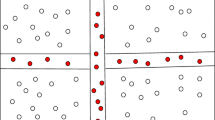Abstract
In wireless sensor networks, all collected data is sent to the sink through multi-hop communication and thus many performance metrics can be affected by the position of that sink especially when the deployment area contains empty zones where nodes cannot be deployed. In this paper, we present a new centroid-based single sink placement technique which exploits information about the shape of the deployment area and the shapes of the empty zones. The position of the single sink is computed using the positions of the centroids of the different geometric shapes in the deployment area. This computed position places the single sink as close as possible, in terms of geographic distance, to every node of the network in order to minimize the latency of communications. Simulation results show improvement of the average latency of communication and the average energy consumption using the centroid-based single sink placement technique compared to existing works.





















Similar content being viewed by others
References
Shi, Y., Hou, Y.T., & Efrat, A. (2006). Algorithm design for base station placement problems in sensor networks. In Proceedings of the 3rd international conference on QSHINE (p. 13). ACM.
Pan, J., Cai, L., Hou, Y. T., Shi, Y., & Shen, S. X. (2005). Optimal base-station locations in two-tiered wireless sensor networks. IEEE Transactions on Mobile Computing, 4(5), 458–473.
Akkaya, K., Younis, M., & Youssef, W. (2007). Positioning of base stations in wireless sensor networks. IEEE Communications Magazine, 45(4), 96–102.
Das, D., Rehena, Z., Roy, S., & Mukherjee, N. (2013). Multiple-sink placement strategies in wireless sensor networks. In 5th international conference COMSNETS (pp. 1–7).
Flathagen, J., Kure, O., & Engelstad, P.E. (2011). Constrained-based multiple sink placement for wireless sensor networks. In IEEE 8th international conference on MASS (pp. 783–788).
Paul, B., Matin, M. A., Showkat, M. J., & Rahman, Z. (2010). Optimal placement of base stations in a two tiered wireless sensor network. WSEAS Transactions on Communications, 1, 43–52.
Akkaya, K., Younis, M., & Bangad, M. (2005). Sink repositioning for enhanced performance in wireless sensor networks. Computer Networks, 49(4), 512–534.
Youssef, W., Younis, M., & Akkaya, K. (2006). An intelligent safety-aware gateway relocation scheme for wireless sensor networks. IEEE International Conference on Communications, 8, 3396–3401.
González-Brevis, P., Gondzio, J., Fan, Y., Poor, H.V., Thompson, J., Krikidis, I., & Chung, P.J. (2011). Base station location optimization for minimal energy consumption in wireless networks. In IEEE 73rd VTC Spring (pp. 1–5).
Bogdanov, A., Maneva, E., & Riesenfeld, S. (2004). Power-aware base station positioning for sensor networks. In 23rd annual conference of the IEEE INFOCOM (Vol. 1).
Oyman, E. I., & Ersoy, C. (2004). Multiple sink network design problem in large scale wireless sensor networks. IEEE International Conference on Communications, 6, 3663–3667.
Sarwar, M. M. S., & Chatterjee, P. (2018). Optimal sink placement in wireless sensor networks to increase network performance. In Industry interactive innovations in science, engineering and technology (pp. 423–433). Singapore: Springer.
Pardesi, P., & Grover, J. (2015). Improved multiple sink placement strategy in wireless sensor networks. In IEEE international conference on futuristic trends on computational analysis and knowledge management (ABLAZE) (pp. 418–424).
O’Madadhain, J., Fisher, D., Smyth, P., White, S., & Boey, Y. (2005). Analysis and visualization of network data using JUNG. Journal of Statistical Software, 10(2), 1–35.
Schmid, S., & Wattenhofer, R. (2006). Algorithmic models for sensor networks. In 14th WPDRTS (pp. 450–459).
Heinzelman, W.R., Chandrakasan, A., & Balakrishnan, H. (2000). Energy-efficient communication protocol for wireless microsensor networks. In HICSS (pp. 3005–3014).
Author information
Authors and Affiliations
Corresponding author
Additional information
Publisher's Note
Springer Nature remains neutral with regard to jurisdictional claims in published maps and institutional affiliations.
Rights and permissions
About this article
Cite this article
Louail, L., Felea, V. Centroid-Based Single Sink Placement in Wireless Sensor Networks. Wireless Pers Commun 108, 121–140 (2019). https://doi.org/10.1007/s11277-019-06391-1
Published:
Issue Date:
DOI: https://doi.org/10.1007/s11277-019-06391-1




